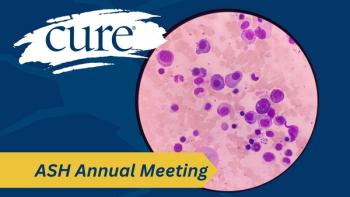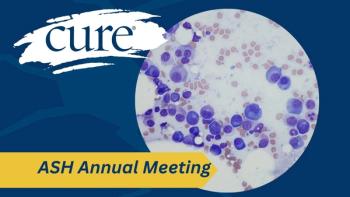Patients with previously treated, locally advanced or metastatic hormone receptor (HR)-positive, HER2-negative breast cancer experienced superior progression-free survival when treated with the TROP2-targeted antibody-drug conjugate (ADC) sacituzumab tirumotecan (sac-TMT; SKB264; MK-2870) compared with chemotherapy, clinical trial results have shown.
Updated findings from the phase 3 OptiTROP-Breast02 trial were presented at the 2025 ESMO Congress in Berlin.
Notably, sac-TMT elicited a 65% reduction in the risk of disease progression or death versus chemotherapy and showed a consistent benefit across subgroups. At a median follow-up of 7.4 months, the median PFS (mPFS) in patients receiving sac-TMT (8.3 months) was approximately twice that of patients receiving chemotherapy (4.1 months).
Glossary
Progression-free survival (PFS): the length of time a person lives with cancer without the cancer getting worse.
Overall survival (OS): the percentage of people in a study who are still alive after a certain period of time.
Objective response rate (ORR): the percentage of patients in a study whose cancer shrinks or disappears after treatment.
Disease control rate (DCR): the percentage of patients in a study whose cancer either shrinks, disappears, or remains stable with treatment.
Duration of response (DOR): the length of time a patient continues to have a response to a treatment without the cancer progressing.
ECOG performance status: a scale that doctors use to describe a patient's general well-being and how capable they are of performing ordinary daily tasks.
Anemia: a condition where your body does not have enough healthy red blood cells to carry adequate oxygen to your tissues, often leading to fatigue.
Neutropenia: a condition in which a person has a low number of neutrophils, which are a specific type of white blood cell important for fighting infection.
Stomatitis: a general term for inflammation or soreness inside the mouth, which can include mouth sores.
Additionally, an interim analysis of overall survival (OS) revealed a positive trend among those receiving sac-TMT compared to those receiving chemotherapy.
“The current chemotherapy options [for HR-positive/HER2-negative breast cancer] show limited efficacy,” said Man Li, professor at the Second Affiliated Hospital of Dalian Medical University, during the presentation. “Sac-TMT has shown promising activity in pretreated patients with HR-positive/HER2-negative metastatic breast cancer in [a] phase 2 study.”
These new statistically significant and clinically meaningful efficacy data from OptiTROP-Breast02, along with an observed manageable safety profile, strengthen the case for sac-TMT as a potential new treatment option for this patient population who comprise a vast majority of global breast cancer cases.
“The OptiTROP-Breast02 study supports sac-TMT as a new treatment option for patients with HR+/HER2– breast cancer following endocrine-based therapy and chemotherapy,” said Li.
What Is the Design of OptiTROP-Breast02?
OptiTROP-Breast02 is a global randomized open-label study evaluating the efficacy and safety of sac-TMT versus investigator’s choice of chemotherapy (ICC) in adult patients with unresectable, locally advanced or metastatic HR-positive/HER2-negative breast cancer who had failed at least one line of systemic chemotherapy. The study is assessing the primary end point of PFS, along with secondary end points of investigator-assessed OS, objective response rate, disease control rate and duration of response.
Patients were eligible for participation if they had HR-positive/HER2-negative breast cancer, had between one and four lines of chemotherapy, and had at least one endocrine therapy, CDK 4/6 inhibitor and taxane in any setting. Of 399 patients randomized to either the investigational arm (200 patients) or control arm (199 patients), 200 received 5 mg/kg of intravenous sac-TMT every 2 weeks, while 196 received ICC including eribulin, capecitabine, gemcitabine and vinorelbine.
What Were the Patient Characteristics in the OptiTROP-Breast02 Trial?
Patient characteristics were well balanced between the study arms. Across both arms, the median age was 54 years, two-thirds had an ECOG performance status of 1, about 53% were HER2 zero and 47% were HER2 low. About 96% of patients had visceral metastases and over three-fourths had liver metastases. About three-fourths of patients had received neoadjuvant chemotherapy and all patients had received prior taxane, endocrine therapy and a CDK 4/6 inhibitor. About 56% of patients had received at least two lines of chemotherapy in the advanced/metastatic setting and a little over one-fourth of patients had primary endocrine resistance.
What Was the Safety Profile of Sac-TMT?
This most recent report of safety data revealed a manageable safety profile, with no new safety signals. In terms of treatment-related side effects, the incidence of all-grade and at least grade 3 (severe) treatment-related side effects was comparable between investigational and control arms. The most common treatment-related side effects for both sac-TMT and chemotherapy were hematologic toxicities, including decreased white blood cell count, anemia and neutropenia. While stomatitis was more frequent in patients receiving sac-TMT (63% versus 8%), Li noted that these side effects were primarily low-grade and manageable.
Treatment discontinuation occurred in 87 and 138 patients in the investigational and control arms, respectively. The most common reason for discontinuation was radiographic disease progression in both the investigational arm (80 patients) and control arm (122 patients).
What Are the Next Steps With Sac-TMT?
Regarding next steps Li said, “Phase 3 studies of sac-TMT as a monotherapy and/or in combination with Keytruda (pembrolizumab) in patients with chemotherapy-naïve HR-positive/HER2-negative breast cancer are ongoing globally and in China.”
REFERENCES:
“Sacituzumab tirumotecan (sac-TMT) vs investigator's choice of chemotherapy (ICC) in previously treated locally advanced or metastatic hormone receptor-positive, HER2-negative (HR+/HER2-) breast cancer (BC): results from the randomized, multi-center phase 3 OptiTROP-Breast02 study” by Man Li, presented at: ESMO 2025 Congress; October 17–20, 2025; Berlin Germany. Abstract LBA23.
For more news on cancer updates, research and education, don’t forget to subscribe to CURE®’s newsletters here.






